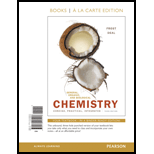
a.
To determine:
The final concentration of given diluted solution.
Concept introduction:
The solution becomes concentrated by the addition of more amount of solute to the solution. Solution is made of solute and solvent. Addition of more solvent results in the formation of dilute solution.
The final concentration of solution is calculate by the formula,
b.
To determine:
The final concentration of given diluted solution.
Concept introduction:
The solution becomes concentrated by the addition of more amount of solute to the solution. Solution is made of solute and solvent. Addition of more solvent results in the formation of dilute solution.
The final concentration of solution is calculate by the formula,
Want to see the full answer?
Check out a sample textbook solution
Chapter 8 Solutions
GENERAL ORGANIC+BIO...(LL)-W/MOD.ACCESS
- Table sugar (C12H22O11) or urea [(NH2)2CO] can be used by road crews to melt ice on roads, but solutions of CaCl2 are generally used instead. Assuming equal costs per pound of substance, why is CaCl2 used instead of table sugar or urea?arrow_forwardSpecifications for lactated Ringers solution, which is used for intravenous (IV) injections, are as follows to reach 100. mL of solution: 285315 mg Na+ 14.117.3 mg K+ 4.9Q.O mg Ca2+ 368408 mg Cl 231261 mg lactate, C3H5O3 a. Specify the amount of NaCl, KCl, CaCl2 2H2O, and NaC3H5O3 needed to prepare 100. mL lactated Ringers solution. b. What is the range of the osmotic pressure of the solution at 37C, given the preceding specifications?arrow_forwardThe Henry's law constant for the solubility of argon gas in water is 1.0103M/atm at 30C. (a) Express the constant in M/mm Hg. (b) If the partial pressure of argon gas at 30C is 693 mm Hg, what is the concentration (in M) of the dissolved argon gas at 30C? (c) How many grams of argon gas can be dissolved in 29 L of water at 693 mm Hg and 30C? (Ignore the partial pressure of water.)arrow_forward
- Consider the following representations of an ionic solute in water. Which flask contains MgSO4, and which flask contains NaCl? How can you tell?arrow_forwardHow do you prepare 150.0 mL of a 0.340 M HCl solution from concentrated 12.0 M HCl? Group of answer choices A. 4.25 mL of concentrated HCl is added to 150.0 mL of DI water. B. 27.2 mL of concentrated HCl is added to 150.0 mL of DI water. C. 27.2 mL of concentrated HCl is diluted to a total volume of 150.0 mL of DI water. D. 4.25 mL of concentrated HCl is diluted to a total volume of 150.0 mL of DI water.arrow_forwardhow much water needs to be added to a 300 ml of 3.0 M solution to obtain a final solution with 2.0 ml 100 ml 150 ml 450 ml 300ml ?arrow_forward
- What volume (in mL) of a 2.5 M NaOH solution is needed to prepare 500.0mL of a 0.10 M NaOH solution? Formula-C1V1=C2V2arrow_forwardpart 1How many ml of a 14M solution must be used to make 250ml of 1.75M? part 2 Water is added to 4L of 6M antifreeze until it is 1.5M, what is the new volume? part 3 1.7L is removed from a 3L solution of 0.2M, what concentration is the remaining solution?arrow_forwardA. Calculate the molarity of the blue stock solution. 10.00 L of the stock solution contains 0.0408 g of Blue #1 food coloring with molar mass = 792.85 g/mol. B. Calculate the concentration of the blue stock solution in parts per million, ppm.Recall: ppm = (mg of solute)/(Liters of Solution) C. Consider the dilutions used to make the solutions and calculate the ppm of each standard solution.(Use C1V1= C2V2)arrow_forward

 Chemistry: An Atoms First ApproachChemistryISBN:9781305079243Author:Steven S. Zumdahl, Susan A. ZumdahlPublisher:Cengage Learning
Chemistry: An Atoms First ApproachChemistryISBN:9781305079243Author:Steven S. Zumdahl, Susan A. ZumdahlPublisher:Cengage Learning ChemistryChemistryISBN:9781305957404Author:Steven S. Zumdahl, Susan A. Zumdahl, Donald J. DeCostePublisher:Cengage Learning
ChemistryChemistryISBN:9781305957404Author:Steven S. Zumdahl, Susan A. Zumdahl, Donald J. DeCostePublisher:Cengage Learning Chemistry: The Molecular ScienceChemistryISBN:9781285199047Author:John W. Moore, Conrad L. StanitskiPublisher:Cengage Learning
Chemistry: The Molecular ScienceChemistryISBN:9781285199047Author:John W. Moore, Conrad L. StanitskiPublisher:Cengage Learning General, Organic, and Biological ChemistryChemistryISBN:9781285853918Author:H. Stephen StokerPublisher:Cengage Learning
General, Organic, and Biological ChemistryChemistryISBN:9781285853918Author:H. Stephen StokerPublisher:Cengage Learning





